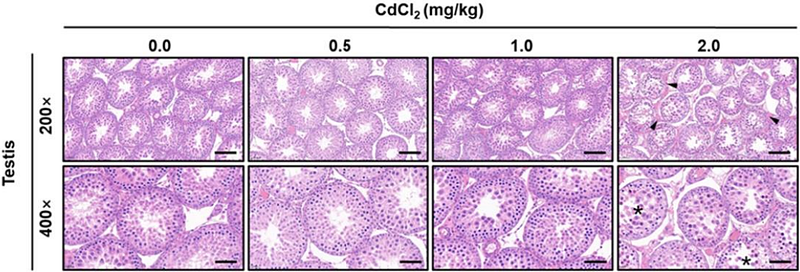Cadmium Disrupts Blood-Testis Barrier (BTB) via An Oxidative Stress-Dependent Autophagy in Prepubertal Rats

Cadmium Disrupts Blood-Testis Barrier (BTB) via An Oxidative Stress-Dependent Autophagy in Prepubertal Rats
man, y.; du, b.; huang, j.; sun, y.; liu, y.; zhang, l.
AbstractBlood testis barrier (BTB) is an important target of cadmium (Cd) toxicology, but the mechanism underlying the Cd-induced impairment of BTB function remains fully elucidated. The mammalian target of rapamycin (mTOR) complex 2 (mTOR2) regulates BTB function via its effects on cellular junctions and the cytoskeleton of Sertoli cells. In this study, we investigated whether mTOR2 was involved in the effects of Cd exposure on BTB integrity. A Cd exposure model in vivo was established in prepubertal male rats using a single intraperitoneal injection of Cadmium Chloride (CdCl2). A Cd exposure model of Sertoli cell was established using a CdCl2-treated TM4 cell line. The Acute cadmium exposure decreased the activity of mTOR2 signaling and adhesin proteins which is linked to the induction of oxidative stress-induced autophagy. In the presence of CdCl2, mTOR, the catalytic subunit of the mTOR2 complex, exhibits a reduction in levels of phosphorylation, accompanied by decreased adhesin proteins and Rictor, the key component of the mTOR2 complex. CdCl2 treatment also drives a process of oxidative stress-induced autophagy, evidenced by alterations in cellular markers for oxidative stress and autophagy. Pharmaceutical inhibition of oxidative stress and/or autophagy alleviates the alternations in mTOR2 signaling and adhesin proteins upon CdCl2 treatment in TM4, a Sertoli cell line. This work is the first to examine the effects of cadmium exposure on rictor/mTOR2 signaling pathways. Our results suggest that Cadmium might exert testicular toxicology via the perturbation in mTOR2 signaling, which can be associated with the cellular stress-related protolysis in Sertoli cells.


